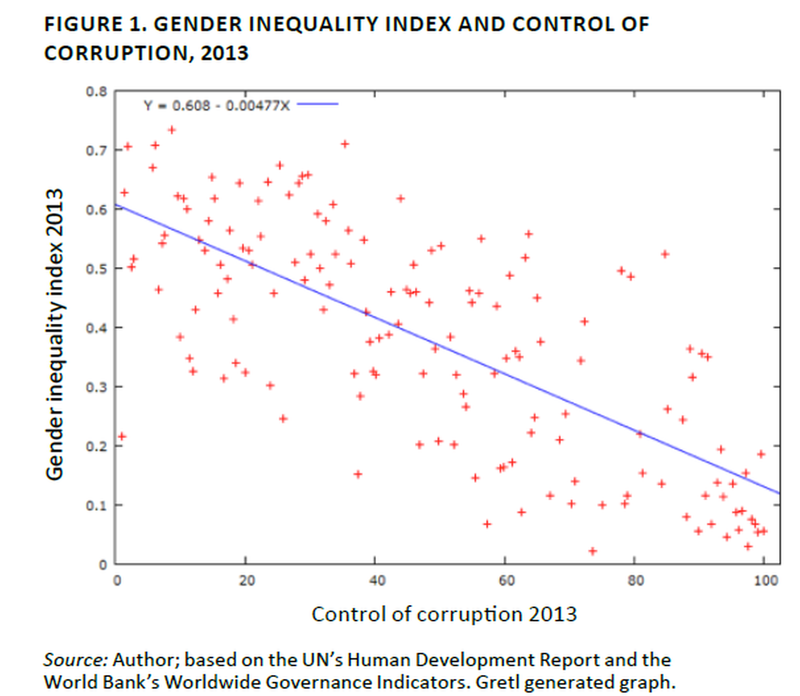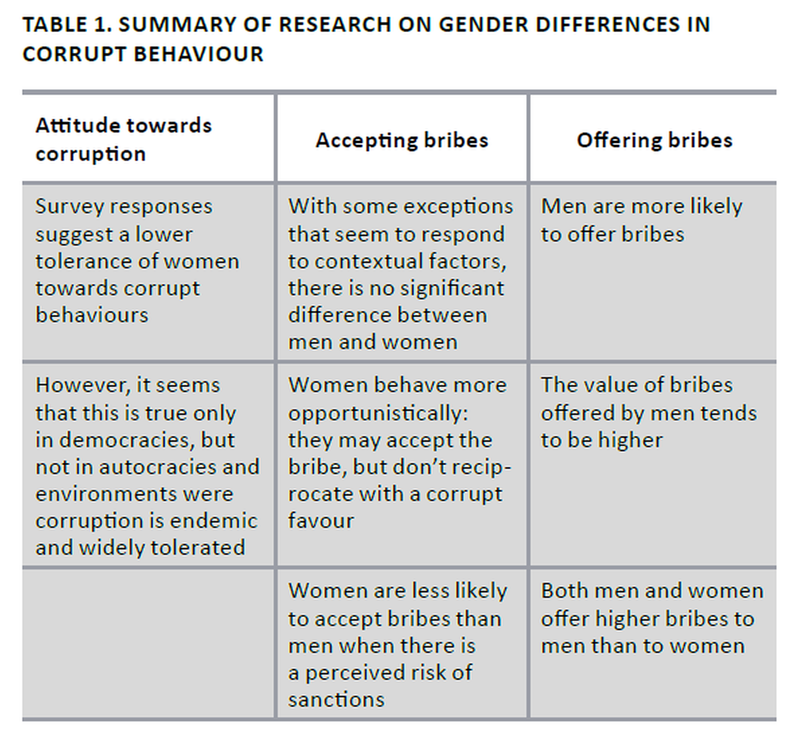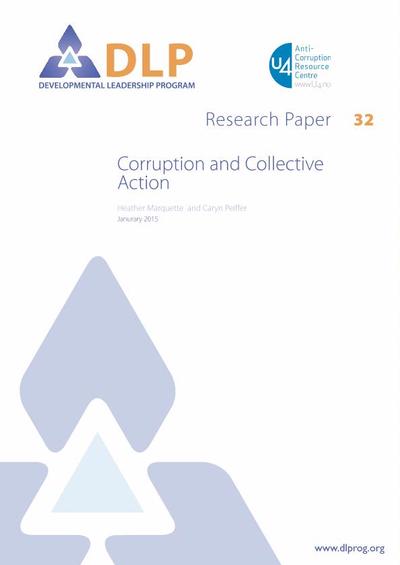Are men and women equally corrupt?
The belief that women are less corrupt than men is widespread, even among development specialists. Variations in risk aversion and reciprocal behaviour may partially explain gender differences in corrupt behaviour and provide some guidance for policy choice. However, nurture seems to trump nature, and contextual factors appear to be the main causes of the observed differences in corrupt behaviour. Ultimately, even if there is no evidence that women are intrinsically less corrupt than men, increasing women’s participation is still a desirable policy choice. Even if it were not to reduce corruption directly, it would contribute to gender equality.
Incorruptible?
Chatting about corruption among traffic officers with a taxi driver in Cusco, Peru, you may well hear something like “it used to be easy to ‘convince’ a policeman to turn a blind eye on a traffic violation or some problem with the license, but now that most traffic officers are women, forget about it: they have no mercy!” Interviews with taxi drivers – arguably the experts on the issue – found similar reactions in Colombia (Fink and Boehm 2011). These reactions reflect a widespread idea: that women are less corrupt than men. The most common explanations for this difference include: women are less selfish; are more charitable and altruistic; or, being mothers, have stronger values. These explanations seem no stronger than simply saying that women are less prone to corruption. However, the idea that women are less corrupt than men is probably not without grounds.
Gender inequality and corruption
Beyond anecdotal evidence, is there a systematic relationship between gender inequality and corruption? A first step to answer this question consists in simply comparing country data on corruption with data on gender inequality. There are different measures available for both variables. When comparing data from the Gender Inequality Index included in the United Nations’ Human Development Report with the Control of Corruption Indicator of the World Bank’s Worldwide Governance Indicators (both for 2013), we find a negative correlation between corruption control and gender inequality. However, correlations can be both attractive and potentially misleading. The correlation only shows that higher gender inequality is observed together with higher levels of corruption. It does not control for other potential explanatory variables and says nothing about causality.

Two pioneering studies by Dollar et al. (2001) – first published as a World Bank working paper in 1999 – and Swamy et al. (2001) explored the correlation more thoroughly. The first study included controls for civil liberties, income and education, and found that lower levels of corruption were indeed associated with a higher proportion of women in parliaments. Swamy et al. (2001) reached the same conclusion, while also showing that lower levels of corruption come along with more women in senior positions in public administration and higher shares of women in the labour force. The resulting policy recommendation by the World Bank in 2001 affirmed that increasing women participation in the public domain would reduce corruption.
However, even including controls and looking at change in the variables, the type of data and methodology used in these studies do not allow any firm conclusion concerning a causal relationship between gender and corruption. Granting there was a causal relationship, it still would be necessary to determine its direction. Does less gender inequality – or more women in positions of authority – result in less corruption because women are more honest than men? Or does less corruption improve gender equality, since lower levels of corruption may suppose better access to legal remedies against discrimination, and therefore facilitate women’s access to positions of authority? Clarifying these issues requires asking the prior question of whether women are actually less corrupt than men. We need to understand possible gender differences in corrupt behaviour and in attitudes towards corruption.
Gender differences in corrupt behaviour
Before looking at specific differences in corrupt behaviour between women and men, it is useful to review the existing evidence on gender differences in general. Experimental research reviewed in Croson and Gneezy (2009) has established some quite robust findings across contexts: compared to men, women are more risk averse (with the exception of female managers), more sensitive to social cues, less competitive, more altruistic and more inclined to cooperate, but they also are generally less trusting and show more flexible ethical standards. About the contentious question of nature versus nurture, research finds evidence for both explanations: some differences are innate; others are a product of the environment. In the available research, the question of whether there are gender differences with respect to corruption is unpacked into three specific issues:
- Gender differences in attitudes towards corruption
- Gender differences in accepting bribes
- Gender differences in offering bribes

Concerning attitudes, survey responses suggest that women show lower tolerance towards corruption. For instance, Swamy et al. (2001), using data from a micro-survey of business firms in Georgia, showed that a firm is significantly less likely to report requests for unofficial payments by public officials when the owner is a woman. Are public officials in Georgia reluctant to ask women in the private sector for bribes, knowing that they condemn corruption and are less likely to pay? The authors do not speculate about this question. Their research, however, also showed that data from the World Values Survey indicates that women are less tolerant towards behaviours that could be described as corrupt.
Esarey and Chirillo (2013), using data from the World Values Survey, found that context matters. In autocracies and where corruption is endemic, women condone corruption as much as men do. In democracies, where corruption tends to be stigmatised to a higher degree, women disapprove of corruption more than men, and are less likely to engage in corrupt practices. This evidence seems to confirm that women are more sensitive to social cues.
However, surveys can be problematic. As Chaudhuri (2012) observes, survey responses may not reflect real life behaviour. Case studies and experimental research can help overcome the limitations of surveys and cross-country comparisons. Experimental designs in particular offer the advantage of observing changes in the variable of interest while holding everything else constant.
While experiments can thus help establish causality, the external validity of their results might be questioned: to what extent do the results hold outside the lab? Fortunately, field experiments where participants ignore that they are part of an experimental setting have shown that at least some of these findings are confirmed in the “real” world.1
Is there evidence that gender differences exist when it comes to taking bribes? Experimental research suggests that the social context seems to be more important than the gender of the participants.
Alatas et al. (2009) carried out a cross-national experiment in Australia, India, Indonesia and Singapore. The study showed that in Australia women accepted significantly fewer bribes than men, while in Singapore the opposite was observed. In India and Indonesia no difference was detected. This is in line with the findings of Esarey and Chirillo (2013).
When someone pays a bribe, he or she is expecting a corresponding favour in return. Since corrupt deals are not enforceable by law, opportunism is an inherent threat to corrupt transactions. Indeed, many corrupt deals fail due to conflicts between the parties. Then, who are more reliable corrupt partners, men or women? In an experiment, Lambsdorff and Frank (2011) observed that women public servants are less inclined to reciprocate, and are thus less reliable corrupt partners. The authors show that this result is supported by international household survey data from the Transparency International Global Corruption Barometer 2009: men are more confident that bribes will be reciprocated. The pattern is also confirmed by Rivas (2013). While she could not find any clear differences between women and men with respect to their inclination to accept bribes, women in her experiment were significantly more likely to behave opportunistically; that is, to accept the bribe without providing the corresponding favour.
Finally, with respect to gender differences in offering bribes, it seems to be better to be bribed by a man than by a woman. Rivas (2013) found that men are more likely to offer bribes and that their value tends to be higher. Actually, it seems better to be a man in either side of the transaction, as the author also finds that both men and women tend to offer higher bribes to male public officials. This result too may reflect the importance of cultural context and of the role that women are expected to play in society.
Implications for policy and programming
At least partially, research findings seem to align with the anecdotic evidence. Some studies found men to be more corrupt, many studies found no differences, but there is hardly any evidence that women are more corrupt than men, as long as sanctions can be expected. Also, research suggests at least two important behavioural factors that may explain why we actually observe gender differences in corrupt behaviour. Both factors are relevant from a policy perspective:
- Risk sensitivity. As women are more risk averse, the standard anti-corruption approach of “control and sanctions” may work better on women. However, this may hold true only for low-level positions. The fact that female managers are no more risk averse than men qualifies this conclusion.
- Reciprocity. Since men tend to reciprocate more than women, women may be a particularly good choice for positions like inspectors or auditors, where there is no pre-existing relationship between the auditor and the auditee. In turn, men may require particularly stringent internal gift policies, as they are more prone to reciprocate favours (Lambsdorff, 2013).
Ultimately, differences in corrupt behaviour, such as the incorruptible nature of police women, may be more related to nurture and culture than to nature. Goetz (2007) argued early on that corruption is genderless: perhaps corrupt institutions corrupt the people working in them, regardless of gender. Women may simply lack opportunities to engage in corruption due to gender inequality in access to senior positions in the private and public sector. They could behave the same as men if they had access to these positions. Also, corruption often happens within insider networks; maybe women are simply too new in the game and have not yet gained access to these networks. Even if we observe a drop in corruption after increasing the share of women in positions of power, this effect may be due mainly to the fact of having introduced outsiders into insider networks – undermining the trust required for corrupt transactions. Thus, it may just be a question of time until corruption rises again as women become insiders, are integrated into corrupt networks, and “learn” how to abuse their positions.
Therefore, future research should try to understand if and how women adapt to corrupt environments. Do women learn to be as corrupt as men? Case studies over longer time horizons and repeated field experiments may be a first step towards answering this question. Also, there is a need to replicate the experiments above in different contexts in order to control for cultural and other differences. More field experiments could help counter criticism about the external validity of experimental research. Another avenue for future research could consist in differentiating between corrupt practices. Most experiments focus on bribery, but there is little evidence regarding favouritism, fraud or embezzlement.
Development cooperation can also contribute to increase our understanding of the gender-corruption nexus. On the one hand, donors could invest in the analysis of possible gender differences in corrupt behaviour, and promote research in countries they are working in. On the other hand, including gender indicators in the design of anti-corruption interventions may facilitate a gender-sensitive impact evaluation and may uncover interesting results confirming or rejecting some of the findings presented here.
Even though the evidence seems to show that women are not inherently less corrupt than men, from a development policy perspective we are faced with a win-win situation. As Chaudhuri (2012) puts it: “at the very least, [increasing the extent of female participation at all levels of government and bureaucracy] will promote gender equity without making matters any worse.”
(In a subsequent U4 brief we explore who suffers more from corruption, men or women).
Alatas, V., L. Cameron, A. Chaudhuri, N. Erkal, and L. Gangadharan. 2009. “Gender, Culture, and Corruption: Insights from an Experimental Analysis.” Southern Economic Journal 75 (3): 663-680.
Armantier, O., and A. Boly. 2011. “A controlled field experiment on corruption.” European Economic Review 55 (8): 1072-1082.
Chaudhuri, A. 2012. “Gender and Corruption: A Survey of the Experimental Evidence.” In New Advances in Experimental Research on Corruption, ed. by D. Serra and L. Wantchekon, 13-49. London: Emerald Books.
Croson, R., and U. Gneezy. 2009. “Gender Differences in Preferences.” Journal of Economic Literature 47(2): 448-474.
Dollar, D., R. Fisman, and R. Gatti. 2001. “Are women really the 'fairer' sex? Corruption and women in government.” Journal of Economic Behavior & Organization 46 (4): 423-429.
Esarey, J., and G. Chirillo. 2013. “‘Fairer Sex’ or Purity Myth? Corruption, Gender, and Institutional Context.” Politics & Gender 9: 361-389.
Fink, H., and F. Boehm. 2011. “Corrupción en la policía de tránsito. Una primera aproximación a través de entrevistas con taxistas colombianos.” Revista Relaciones 32 (126): 67-85.
Frank, B., J. G. Lambsdorff, and F. Boehm. 2011. “Gender and Corruption. Lessons from Laboratory Corruption Experiments.” European Journal of Development Research 23 (1): 59-71.
Goetz, A. M. 2007. “Political Cleaners: Women as the New Anti-Corruption Force?” Development and Change 38 (1): 87-105.
Lambsdorff, J. G., and B. Frank. 2011. “Corrupt Reciprocity – Experimental Evidence on a Men’s Game.” International Review of Law and Economics 31 (2): 116-125.
Lambsdorff, J. G. 2013. “Behavioral and experimental economics as a guidance to anticorruption.” In New Advances in Experimental Research on Corruption, ed. by D. Serra and L. Wantchekon. London: Emerald Books.
Rivas, M. F. 2013. “An experiment on corruption and gender.” Bulletin of Economic Research 65 (1): 10-42.
Schulze, G. G., and B. Frank. 2003. "Deterrence versus intrinsic motivation: Experimental evidence on the determinants of corruptibility.” Economics of Governance 4 (2): 143-60.
Sung, H. E. 2003. “Fairer Sex or Fairer System? Gender and Corruption Revisited.” Social Forces 82 (2): 703-723.
Sung, H.E. 2012. “Women in government, public corruption, and liberal democracy. A panel analysis.” Crime, Law and Social Change 58 (3): 195-219.
Swamy, A., S. Knack, Y. Lee, and O. Azfar. 2001. “Gender and Corruption.” Journal of Development Economics 64 (1): 25–55.
World Bank. 2001. Engendering development through gender equality in rights, resources, and voice. New York: World Bank-Oxford University Press.





